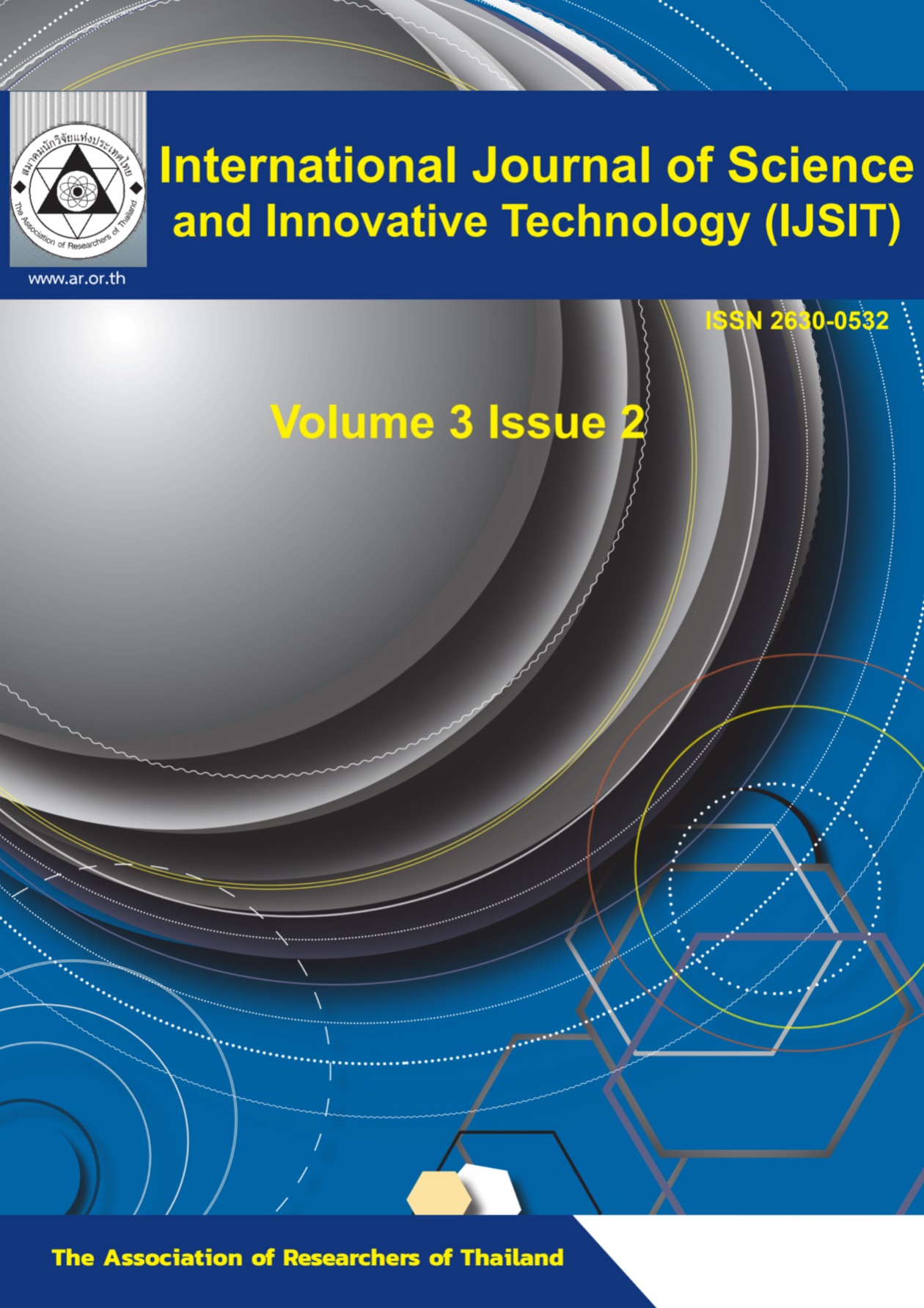Natural rubber-based mechanical modifiers for poly(lactic acid)
Main Article Content
Abstract
Poly(lactic acid) (PLA), a compostable and biodegradable polymer, is a high-brittle polymeric material. Therefore, mechanical propertyimprovement of the PLA is challenging byutilization of natural rubber (NR), a green elastomeric and renewable materials. In this study, NR and chemically modified NR to epoxidized NR(ENR) are explored as impact modifiers for the PLA. The as-prepared ENR with 30 mol% epoxide content (E30NR) and NR are melt-blended with PLA at various rubber contents (1 to 5 wt.%). The result illustrates the concurrent increment in elongation ability and impact performance of PLA, approximately elevenfold and twofold,respectively, with adding 5 wt.% E30NR compared with those of NR/PLA blends with the same rubber content. In addition, the 5 wt.% E30NR is an efficient impact modifier for PLA as the elongation at break and the impact strength is increased approximately fifteen and four times, respectively,compared to the PLA. The E30NR/PLA blends launch superior modulus and strength when compared to NR/PLA blends. Furthermore, E30NR/PLA films transparency demonstrated from transmittance percentage shows higher transparency than NR/PLA blend films. Consequently, NR-based utilization as a mechanical modifier could be considered a sustainable and alternative way for the value-addedof NR and increment of PLA’s applications.
Article Details
References
Becker, J.M., Pounder, R.J. & Dove, A.P. (2010). Synthesis of poly(lactide)s with modified thermal and mechanical properties. Macromolecular Rapid Communications 31, 1923-1937.
Bitinis, N., Verdejo, R., Cassagnau, P. & Lopez-Manchado, M.A. (2011). Structure and properties of polylactide/natural rubber blends. Materials Chemistry and Physics 129, 823-831.
Hamad, K., Kaseem, M., Yang, H.W., Deri, F. & Ko, Y.G. (2015). Properties and medical applications of polylactic acid: A review. EXPRESS Polymer Letters 9, 435-455.
Hamzah, R., Bakar, M.A., Dahham, O.S., Zulkepli, N.N. & Dahham, S.S. (2016). A structural study of epoxidized natural rubber (ENR-50) ring opening under mild acidic condition. Journal of Applied Polymer Science 133, 44123.
Juntuek, P., Ruksakulpiwat, C., Chumsamrong, P. & Ruksakulpiwat, Y. (2012). Effect of glycidyl methacrylate-grafted natural rubber on physical properties of polylactic acid and natural rubber blends. Journal of Applied Polymer Science 125, 745-754.
Mathlouthi, M. (1994). Food Packaging and Preservation. Elsevier Applied Science, Blackie, Glasgow, UK.
Phetphaisit, C.W., Wapanyakul, W. & Phinyocheep, P. (2019). Effect of modified rubber powder on the morphology and thermal and mechanical properties of blown poly(lactic acid)–hydroxyl epoxidized natural rubber films for flexible film packaging. Journal of Applied Polymer Science 136, 47503.
Phinyocheep, P., Phetphaisit, C.W., Derouet, D., Campistron, I. & Brosse, J.C. (2005). Chemical degradation of epoxidized natural rubber using periodic acid: Preparation of epoxidized liquid natural rubber. Journal of Applied Polymer Science 95, 6-15.
Pyay, S., Thanungkano, W., Mungkalasiri, J. & Musikavong, C. (2019). A life cycle assessment of intermediate rubber products in Thailand from the product environmental footprint perspective. Journal of Cleaner Production 237, 117632.
Rosli, N.A., Ahmad, I., Anuar, F.H. & Abdullah, I. (2016). Mechanical and thermal properties of natural rubber-modified poly(lactic acid) compatibilized with telechelic liquid natural rubber. Polymer Testing 54, 196-202.
Saengdee, L., Phinyocheep, P. & Daniel, P. (2020). Chemical modification of natural rubber in latex stage for improved thermal, oil, ozone and mechanical properties. Journal of Polymer Research 27, 275.
Samran, J., Phinyocheep, P., Daniel, P. & Kittipoom, S. (2005). Hydrogenation of unsaturated rubbers using diimide as a reducing agent. Journal of Applied Polymer Science 95, 16-27.
Smitthipong, W., Suethao, S., Shah, D. & Vollrath, F. (2016). Interesting green elastomeric composites: Silk textile reinforced natural rubber. Polymer Testing 55, 17-24.
Sun, Z., Xiao, J., Tao, L., Wei, Y., Wang, S., et al. (2018). Preparation of high-performance carbon fiber-reinforced epoxy composites by compression resin transfer molding. Materials 12, 13.
Tessanan, W., Chanthateyanonth, R., Yamaguchi, M. & Phinyocheep, P. (2020). Improvement of mechanical and impact performance of poly(lactic acid) by renewable modified natural rubber. Journal of Cleaner Production 276, 123800.
Thomas Kurian & Mathew, N.M. (2011). Natural Rubber: Production, Properties and Applications, in: Susheel Kalia&Avérous, L. (Eds.), Biopolymers. pp. 403-436.
Toki, S., Sics, I., Ran, S., Liu, L., Hsiao, B.S., et al. (2002). New Insights into Structural Development in Natural Rubber during Uniaxial Deformation by In Situ Synchrotron X-ray Diffraction. Macromolecules 35, 6578-6584.
Zhang, C., Man, C., Pan, Y., Wang, W., Jiang, L., et al. (2011). Toughening of polylactide with natural rubber grafted with poly(butyl acrylate). Polymer International 60, 1548-1555.


